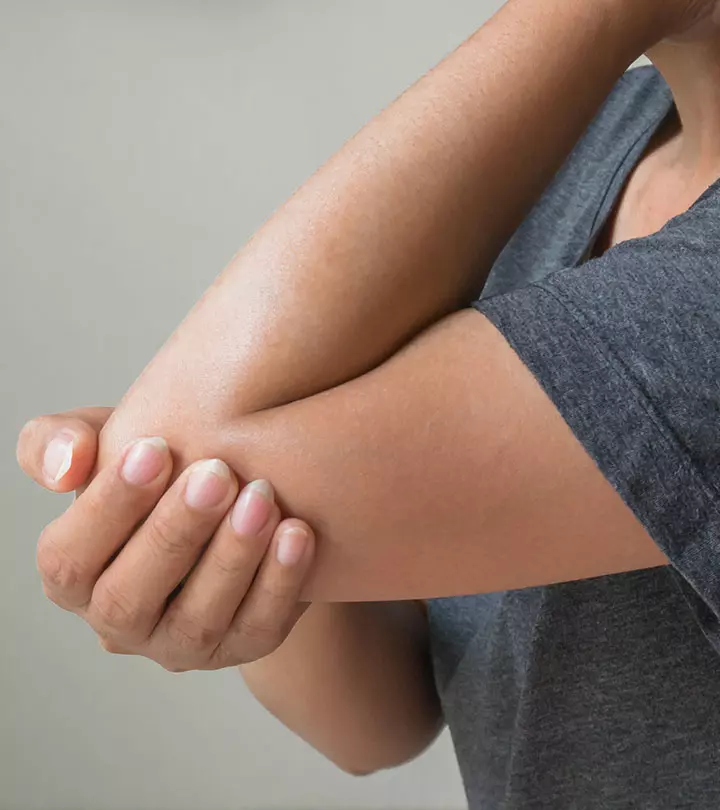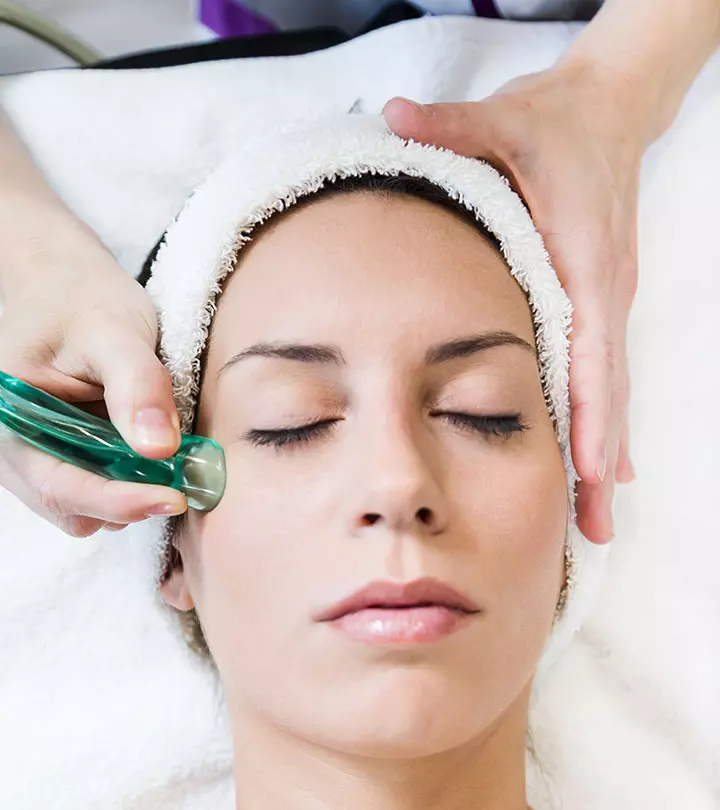How To Treat Calcium Deposits In Skin And Face
Getting rid of those yellow bumps has never been easier than with these effective remedies.

Image: Shutterstock
Calcium deposits on the skin can form unexpectedly and without any warning. These bumps could be a sign of an underlying medical problem. Calcium deposits on the skin may look like tiny, firm yellow or white bumps and can be caused by several factors.
The bumps can appear anywhere on the body, including the face, and are caused by excessive calcium phosphate in the skin. What are its causes? What are your options for dealing with these skin conditions? Read this article to learn all about this condition and its treatment.
In This Article
What Are Calcium Deposits In The Skin?
Calcium deposits in the skin are medically termed as calcinosis cutis.
Calcium salts are deposited in the skin and the subcutaneous tissue. These bumps may appear on any part of the body but are most commonly found on the fingertips, elbows, knees, and scrotum. They may also appear on the face in some cases. Calcinosis cutis is also often associated with systemic sclerosisi A group of skin diseases that causes the hardened skin, joint pains, and heartburn in middle-aged women. (1).
A study conducted with 568 patients of systemic sclerosis found that 215 (38%) patients had calcinosis or calcium deposits in their skin. Calcinosis was commonly found in the hands of 70% of the patients, on the thumbs of 19%, and on the fifth fingers of 8% which slowed their movement. 29% of the patients experienced tenderness, 20% had bumps protruding through their skin, and 2% had infections.
Unfortunately, calcium deposits tend to occur without any warning. The appearance of stiff, white bumps under the skin with a pimple-like appearance is usually the most notable calcinosis cutis symptom. Other symptoms of this condition are listed in the next section.
Key Takeaways
- Hard bumps of different sizes with mild pain or stiffness are symptoms of calcium deposits in the skin and face.
- Excess calcium phosphate is caused by certain medications, trauma, infections, and inflammation.
- The five types of calcium deposits are dystrophic calcinosis cutis, iatrogenic calcinosis cutis, metastatic calcinosis cutis, idiopathic calcinosis cutis, and calciphylaxis
- Certain non-invasive and invasive procedures and natural remedies can help treat this condition.
Symptoms Of Calcium Deposits In The Skin

In addition to the firm, pimple-like nodules under the skin, calcinosis cutis also has other symptoms:
- Hard bumps or nodules appear in clusters of varying sizes.
- While most bumps are painless, some may cause tenderness and mild pain.
- If bumps arise near joints, they could lead to stiffness and pain.
- If these calcium deposits are punctured, you will find a chalky white material oozing out.
Visit your doctor if you notice any calcium spots on your skin. Your doctor would assess the symptoms and refer you to appropriate clinical investigations to establish the further course of action.
How Is Calcinosis Cutis Diagnosed?
As calcium deposits are often the result of increased calcium phosphate levels in the body, your doctor may recommend laboratory tests to determine any metabolic abnormalities. Biopsyi The procedure that involves the removal of a group of cells or tissue from different body parts for testing. of cutaneous lesions is often performed to confirm the diagnosis. X-rays are another way to check for calcified crystals under the skin.
Medical investigations are also used to determine the underlying cause, which eventually determine the line of treatment your doctor will recommend for the condition.
Calcinosis cutis is a rare condition but is attributable to several causes, as explained in the next section.
Causes For Calcium Deposits Under The Skin

Calcium deposits on the face, arms, legs, and other parts of the body become visible when there’s an excess amount of calcium phosphate deposited in the skin and the subcutaneous tissuei The innermost layer of the skin, beneath the first two layers, namely the epidermis and the dermis. .
Calcium is an important mineral. The body uses calcium phosphate for building healthy bones and teeth, and for boosting muscle and nerve function.
However, trauma, inflammation, some infections, and even certain types of medications may increase the levels of calcium and phosphorous in the body. Certain autoimmune disorders are also said to result in calcinosis cutis. Certain lifestyle factors may also contribute to calcium deposits. These include a diet high in calcium-rich foods and processed sugars, a sedentary lifestyle, smoking, excessive alcohol consumption, and excess vitamin D intake (primarily through supplements). All these can disrupt calcium metabolism and lead to calcium accumulation in tissues.
 Quick Tip
Quick TipMedically, five different types of calcium deposits have been identified. We have discussed them in the following section.
Types Of Calcium Deposits In The Skin
Calcium deposits in the skin are generally divided into the following five sub-types.
1. Dystrophic Calcinosis Cutis
Injury, trauma, and skin infections might lead to dystrophic calcinosis cutis.
Though the calcium and phosphorous levels in the body are normal, the phosphate proteins released by the dying tissue lead to the calcification of the area (1).
Common causes of tissue damage include:
- Tumors
- Acne
- Skin infections
- Systemic sclerosis
- Connective tissue diseases like lupusi A disease that causes our body’s immune system to attack its own cells and organs, leading to inflammation.
2. Latrogenic Calcinosis Cutis
This type of calcinosis is attributable to certain medication and repeated medical procedures, like drawing blood from an infant’s heel. Calcium deposits may also appear at the site of an invasive procedure as a side effect, leading to iatrogenic calcinosis (1).
Some of the identified reasons for this type of calcinosis are:
- Heel sticks in newborns
- Administration of solutions or medicines with calcium and phosphate
- Intravenous calcium chloride and calcium gluconate used in the treatment of certain diseases
- Prolonged exposure to the electrode paste used during an electromyograph
3. Metastatic Calcinosis Cutis

High calcium phosphate levels in the body lead to calcium salts that may form nodules on the skin. Causes for high levels of calcium and phosphate include (1):
- Kidney problems
- Excessive intake of vitamin D
- Hyperthyroidismi Excess production of the hormone by the thyroid gland leading to weight loss and irregular heartbeat.
- Milk-alkali syndrome, which refers to excessive calcium intake from foods and antacids
- Bone diseases, like Paget’s disease
- Sarcoidosis
4. Idiopathic Calcinosis Cutis
This type of calcinosis cannot be attributed to a particular cause. The cause of idiopathic calcinosis cutis is unclear, though it is not caused by any of the usual factors. It may appear in the form of nodules on the scrotum or bumps just below the skin (1).
5. Calciphylaxis

This is an uncommon condition where calcium accumulates in the small blood vessels of the skin and fat tissues (1). It may lead to painful ulcers on the skin and blood clots. If untreated, serious flare-ups may even lead to death.
The causes for calciphylaxis remain unknown, but some of the associated factors include obesity, diabetes, chronic kidney failure, and hyperparathyroidism.
Calcinosis Cutis does have certain treatment options available. We have discussed the same in the next section.
How To Treat Calcium Deposits Under The Skin
It is important to establish the underlying cause of calcinosis cutis before proceeding with the treatment. Medical therapy may relieve symptoms, but no specific cure has yet been found for the condition.
- Non-Invasive Procedures
No treatment has been accepted as standard therapy for calcinosis yet. However, various medicines have been reported to be beneficial, including the use of warfarin, bisphosphonates, minocycline, ceftriaxone, diltiazem, aluminum hydroxide, probenecid, intralesional corticosteroids, and intravenous immunoglobulin (2).
In another review, minocycline was found to be a viable treatment option for calcification associated with systemic sclerosis (3). While the medicine only moderately reduced the size of the skin lesions, it did reduce ulceration and inflammation.
Dr. Daniel Cobb, DOM, shared his experience of treating calcium deposits with DMSO (dimethyl sulfoxide) and ascorbic acid. He said, “I mixed some of the pure ascorbic acid with enough DMSO to turn the mixture into a thin paste. I rubbed it on the skin at the location of the calcium deposit. In the next couple of hours, I repeated this three more times. By the next morning, the pain was almost totally gone (i).”
Another method of eliminating skin calcifications is via extracorporeal shock wave lithotripsyi A technique of breaking down stones inside the urinary tract, bile, or pancreatic ducts using shockwaves passed through the body. (ESWL) (4). Your doctor will use sound waves to break the calcium salts, allowing your body to absorb them.
- Invasive Procedures
In some cases, your doctor may perform invasive techniques to remove the calcium deposits from the skin. Some methods include curettagei Named after the surgical instrument called the curette, the procedure involves the removal of the tissue lining in the uterine cavity. and carbon dioxide laser treatments (1).
 Trivia
TriviaHowever, the deposits may reappear even after surgery, depending on the severity and type of condition. Therefore, it is imperative to identify the root cause of the disease and work towards eliminating it.
You may also consider the following alternative treatments for managing a case of calcinosis cutis.
How To Treat Calcium Deposits Under The Skin Naturally

While there’s no proven remedy for removing calcium deposits, there are a few natural remedies that may help you deal with the condition.
- Diet
A low calcium and phosphate diet may help treat calcium deposits in the skin (5). However, changing your diet alone may not reduce the bumps and may be ineffective altogether if the case is severe.
- Massage
Some natural healers recommend massaging the affected areas with aloe vera and coconut oil to eliminate calcium deposits. Massages, when supplemented with other treatment methods, have been shown to reduce the deposition of calcium in tendons by improving the blood flow to the area (6).
Heat massage may also help treat the underlying conditions for calcinosis, including Raynaud’s disease. However, there is not enough evidence to prove the effectiveness of this technique.
- ACV
In mice studies, regular intake of apple cider vinegar in water aided calcium absorption (7). It is believed that drinking one tablespoon of apple cider vinegar with a glass of water daily may break down calcium deposits in the body. However, there is no research to support this remedy.
- Chanca Piedra
Chanca piedra, which means ’stone breaker’, is another name for Phyllanthus niruri, a plant often used to break down kidney stones. Anecdotal evidence suggests that chanca piedra extracts may help eliminate calcium deposits. However, this natural treatment has limited concrete research.
Do Calcium Deposits Disappear On Their Own?
Fortunately, calcium bumps tend to disappear on their own in some cases. Smaller deposits are often absorbed by your body in a month or two. But in extreme cases, the hardened bumps on your skin may not clear out on their own. In such cases, you should get the deposits removed immediately.
Are Calcium Deposits Harmful?
Although calcium deposits are not generally harmful, it is advisable not to leave them untreated.
If the calcium deposits on the face or skin last longer than 1 to 2 months, cause extreme pain and discomfort, or continue to grow in size or number, you should contact your doctor immediately.
Infographic: Methods To Treat Calcium Deposits Under The Skin
Calcium salt deposits can collect in the subcutaneous layer of the skin, resulting in painless but visible bumps and lumps. While there may be various reasons and underlying medical issues for this condition, and it is best to seek medical advice in case of occurrence, there are a few treatment routes you can look to for calcinosis cutis management. Scroll down and check out the infographic for more details.

Illustration: StyleCraze Design Team
Calcium deposits appear as tiny, firm, yellow, or whitish bumps or hard lumps under the skin. While these aren’t harmful, they could signal underlying medical conditions. Should you discover such deposits, consult a dermatologist and get them diagnosed.
You can manage the condition if you find out the cause early. Diet, massages, and other medical treatments will help you relieve the condition. With timely treatment and proper skin care, you can get rid of calcium deposits, and manage overall skin health.
Frequently Asked Questions
Can calcium deposits be cancerous?
It depends on many factors. For instance, calcium deposits in breast tissue are referred to as breast calcifications. They appear as white dots or specks on mammography. They become more common after age 50. Despite the fact that most breast calcifications are benign (noncancerous), specific calcification patterns, such as tight clusters with atypical forms and a fine appearance, may be a sign of breast cancer or other precancerous changes in the breast tissue.
Does magnesium get rid of calcium deposits?
Yes, magnesium may have a moderate effect on getting rid of calcium deposits.
Can I use over-the-counter creams or ointments to treat calcium deposits?
Yes, your dermatologist may suggest over-the-counter creams or steroid ointments along with oral medications to reduce the inflammation and appearance of the calcium deposits.
How long does it take to see results from treatment for calcium deposits?
While it depends on the severity of the lesions, it may take approximately between 3-4 weeks to see visible results.
Illustration: Calcium Deposits In The Skin: Symptoms Causes And Treatment

Image: Stable Diffusion/StyleCraze Design Team
Learn how to remove painful calcium deposits from your body with three easy home remedies. Watch this video to learn how to get rid of them quickly and safely.
Personal Experience: Source
StyleCraze's articles are interwoven with authentic personal narratives that provide depth and resonance to our content. Below are the sources of the personal accounts referenced in this article.
i. Melting Calcium Deposits with Ascorbic Acidhttps://drdanielcobb.blogspot.com/2012/05/melting-calcium-deposits.html
References
Articles on StyleCraze are backed by verified information from peer-reviewed and academic research papers, reputed organizations, research institutions, and medical associations to ensure accuracy and relevance. Read our editorial policy to learn more.
- Calcinosis Cutis
https://www.ncbi.nlm.nih.gov/books/NBK448127/ - Calcinosis cutis: part II. Treatment options
https://pubmed.ncbi.nlm.nih.gov/21679811/ - Treatment of cutaneous calcinosis in limited systemic sclerosis with minocycline
https://pubmed.ncbi.nlm.nih.gov/12594118/ - Treatment of calcinosis cutis by extracorporeal shock-wave lithotripsy
https://pubmed.ncbi.nlm.nih.gov/21745699/ - Cutaneous Tumors and Tumor Syndromes: Calcinosis Cutis
https://www.sciencedirect.com/topics/medicine-and-dentistry/calcinosis-cutis - A conservative management protocol for calcific tendinitis of the shoulder
https://pubmed.ncbi.nlm.nih.gov/10626706/ - Enhancing effect of dietary vinegar on the intestinal absorption of calcium in ovariectomized rats
https://pubmed.ncbi.nlm.nih.gov/10380633/
Read full bio of Dr. Sonam Jeswani Ramrakhiani
Read full bio of Arshiya Syeda
Read full bio of Ramona Sinha
Read full bio of Monomita Chakraborty



























Community Experiences
Join the conversation and become a part of our empowering community! Share your stories, experiences, and insights to connect with other beauty, lifestyle, and health enthusiasts.